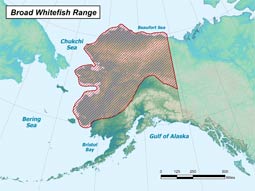Broad Whitefish
(Coregonus nasus)
Species Profile
Did You Know?
Broad whitefish are an important subsistence fish in Alaska.
General Description
The broad whitefish has an elongated body covered in silvery scales. Its body from back to belly, however, is very broad (hence the fishes’ name) compared to other whitefish species. From the mouth to the back, just above the gill plate, the broad whitefishes’ body rises at a sharp angle giving it a much more blunt face and meatier head than other whitefishes. The broad whitefish has a very small, slightly down-turned mouth; adapted for feeding off the bottom. As with other whitefishes its caudal (tail) fin is deeply forked. It has an adipose fin (fleshy fin on the back behind the dorsal fin, close to the tail fin) making the broad whitefish (all whitefish, actually) a member of the Salmonid family. Fins are dark. The belly is white to faded yellow and cheeks may have brown, frecklish spots.
Life History
Growth and Reproduction
Broad whitefish mature at a late age as compared to other salmonids (members of the salmon family). Most become mature between eight and ten years old. They live a long time; some reaching an age of 20+ years.
Not all broad whitefish spawn every year. In some river systems, they spawn every other year or so. Broad whitefish spawn in Alaska’s rivers and streams from fall to early winter. Some broad whitefish travel from streams in which they spent their summer feeding, to streams that have better habitat for spawning. Broad whitefish congregate over gravel and release eggs and milt. The eggs are heavier than water, so they sink to the bottom and lodge in the gravel. The eggs hatch in the spring, and the young fish move downstream to feeding areas.
Feeding Ecology
Broad whitefish are bottom feeders. They eat snails, bivalves and other mollusks, as well as aquatic insect larvae. It was noted that in the Kuskokwim River, broad whitefish do not eat at all between fall spawning and spring the following year.
Migration
Most broad whitefish are amphidromous, which means they are able to move from freshwater to nearshore marine waters and vice versa at various times in their lives. Some broad whitefish do not go to sea at all. We call them “residents.”
Most broad whitefish stay within a river system, but migrate between streams within the main drainage. They target small stream and lake systems for summer feeding. Whitefish begin their migration to fall spawning areas in mid to late summer depending on the distance they must travel. Some broad whitefish migrate downstream and into the sea in order to reach a prime freshwater spawning area. After spawning the fish will move to overwintering areas, such as deep pools or brackish water. In spring, broad whitefish migrate to feeding areas.
Range and Habitat
In Alaska, broad whitefish occur throughout the freshwater drainages of the Bering Sea (including the Yukon and Kuskokwim rivers) and drainages of the Chukchi Sea and the Arctic Ocean. Broad whitefish can tolerate some salt water, so they may also be found in the brackish waters of these systems. They are also found in northern, coastal systems of Canada and Russia.
Status, Trends, and Threats
Status
The status of broad whitefish populations in Alaska is unknown.
Trends
Because we know little about broad whitefish life history, trends cannot be predicted.
Threats
Because broad whitefish migrate between streams and rivers, any development that blocks fish from moving up or downstream, such as inadequate culverts or dams, could be potentially harmful. Anything that changes salinity, pH, dissolved oxygen levels or temperature in waters used by broad whitefish in any stage of their life has potential to cause harm (e.g. Activities such as off shore oil spills, large scale in-river gravel mining or global warming.)
Fast Facts
-
Size
Mature broad whitefish average from two to five kilograms (~4.5 to 11 pounds) In North Slope waters, mature fish are largest in the Colville and Chipp river areas and smallest on the eastern edge of their Alaska distribution. Generally, mature fish on the slope run 500 to 600 mm (~ 9.5 to 23.5 inches). -
Range/Distribution
In Alaska, broad whitefish occur throughout the freshwater drainages of the Bering Sea (including the Yukon and Kuskokwim rivers) and drainages of the Chukchi Sea and the Arctic Ocean. Broad whitefish can tolerate some salt water, so they may also be found in the brackish waters of these systems. They are also found in northern, coastal systems of Canada and Russia. -
Diet
Mollusks and aquatic insects -
Predators
Humans, bears, other fish such as burbot -
Reproduction
Every year or every other year -
Remarks
Broad whitefish are not managed


